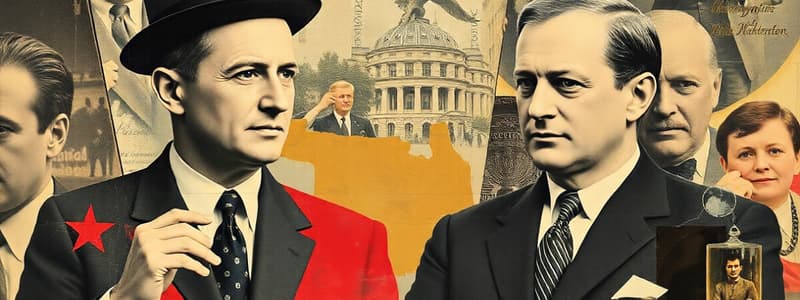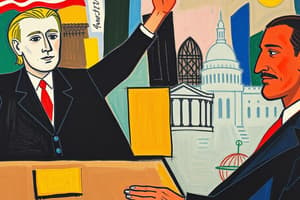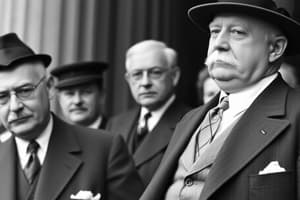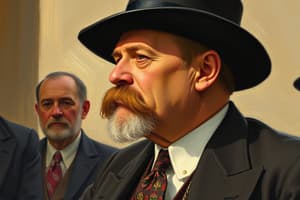Podcast
Questions and Answers
What was the primary platform of Warren G. Harding during his presidential campaign in 1920?
What was the primary platform of Warren G. Harding during his presidential campaign in 1920?
- Pro-agriculture initiatives
- A return to normalcy (correct)
- Support for increased immigration
- Pro-business policies
Which scandal is associated with Secretary of the Interior Albert Fall during Harding's administration?
Which scandal is associated with Secretary of the Interior Albert Fall during Harding's administration?
- Iran-Contra Affair
- Teapot Dome Scandal (correct)
- Watergate Scandal
- Monica Lewinsky Scandal
What economic approach did Calvin Coolidge take to support the economy during his presidency?
What economic approach did Calvin Coolidge take to support the economy during his presidency?
- High tariffs on imported goods (correct)
- Increasing taxes
- Wartime controls
- Expanding immigration
What was the ultimate outcome of Herbert Hoover's presidency shortly after he took office?
What was the ultimate outcome of Herbert Hoover's presidency shortly after he took office?
Which factor contributed to the increasing trust in President Calvin Coolidge among American citizens?
Which factor contributed to the increasing trust in President Calvin Coolidge among American citizens?
During the 1920s, what was a major political change that occurred under Harding's presidency?
During the 1920s, what was a major political change that occurred under Harding's presidency?
What was a significant economic characteristic of the Roaring 20s under Republican leadership?
What was a significant economic characteristic of the Roaring 20s under Republican leadership?
What major political shift occurred in the United States during the 1920s?
What major political shift occurred in the United States during the 1920s?
Which president led the United States during World War I?
Which president led the United States during World War I?
What was a significant consequence of the U.S. withdrawal from progressive politics by 1920?
What was a significant consequence of the U.S. withdrawal from progressive politics by 1920?
Why was President Wilson unable to gain support for the League of Nations?
Why was President Wilson unable to gain support for the League of Nations?
What was the predominant political sentiment among many American citizens after World War I?
What was the predominant political sentiment among many American citizens after World War I?
What role did Warren G. Harding play in the political transformation of the 1920s?
What role did Warren G. Harding play in the political transformation of the 1920s?
Which group was notably opposed to the League of Nations?
Which group was notably opposed to the League of Nations?
What marked the end of the progressive political era in the United States?
What marked the end of the progressive political era in the United States?
Flashcards
1920s Political Shift
1920s Political Shift
The U.S. shifted from progressive policies to a more conservative approach during the 1920s.
Progressive Era
Progressive Era
A period of social and economic reforms in the early 20th century (1910s).
League of Nations
League of Nations
An international organization formed to prevent future wars through peaceful resolutions.
Wilson's Foreign Policy Disapproval
Wilson's Foreign Policy Disapproval
Signup and view all the flashcards
1920 Election Outcome
1920 Election Outcome
Signup and view all the flashcards
Republican Victory
Republican Victory
Signup and view all the flashcards
Post-War Disillusionment
Post-War Disillusionment
Signup and view all the flashcards
Conservative Ideology
Conservative Ideology
Signup and view all the flashcards
Harding's Presidency
Harding's Presidency
Signup and view all the flashcards
Teapot Dome Scandal
Teapot Dome Scandal
Signup and view all the flashcards
Return to Normalcy
Return to Normalcy
Signup and view all the flashcards
Coolidge Presidency
Coolidge Presidency
Signup and view all the flashcards
1920s Economic Boom
1920s Economic Boom
Signup and view all the flashcards
Herbert Hoover
Herbert Hoover
Signup and view all the flashcards
Pro-business policies
Pro-business policies
Signup and view all the flashcards
Study Notes
1920s U.S. Political Transformation
- Progressive politics of the 1910s, focusing on worker's rights, migrant/minority rights, and women's rights, lost popularity by the end of WWI.
- President Wilson's leadership in WWI and the League of Nations initiatives were controversial, dividing public opinion .
- Opposition to the League of Nations, particularly among German and Irish immigrants, wanted US focus on domestic economic recovery.
- Republican nominee Warren G. Harding, promising a return to "normalcy", won the 1920 election.
- This signaled a shift from progressive liberalism to conservative ideology.
Harding Administration and the Teapot Dome Scandal
- Harding's 1921 campaign and victory mark a sharp political turn, away from progressive ideals.
- Harding appealed to voters seeking a return to post-war stability.
- Harding's administration faced controversy due to corruption, notably the Teapot Dome Scandal involving Secretary of Interior Albert Fall.
- Fall accepted bribes for awarding oil drilling rights and was the first Cabinet member convicted of a felony.
- Similar corruption incidents during previous presidencies, such as Grant's, were compared to the Harding administration.
- Harding's actions resulted in tax cuts and the revival of the US economy, though faced corruption issues.
Coolidge's Presidency and Economic Prosperity
- Coolidge, taking over after Harding's death, prioritized tax cuts and furthered pro-isolation stance in foreign policy.
- He was known for honesty, strengthening public trust and was re-elected in 1924.
- Coolidge's pro-business approach lead to booming economic growth, reduced working hours, and increased consumer spending. This period is often referred to as the "Roaring Twenties".
Herbert Hoover and the Republican Political Dominance
- The success of the Republican Party continued with Herbert Hoover's win in 1928.
- As Secretary of Commerce, Hoover was deeply involved during Harding and Coolidge's presidencies, carrying their political ideals into his administration.
- This continuity in political ideology fostered a period of prosperity and technological advancements, a key component of the Roaring Twenties.
- Hoover's victory was an affirmation of the established Republican political dominance and focus on economic prosperity.
- Hoover's victory marked an enduring political transformation, with the Republicans maintaining their political dominance.
- Unfortunately, his term was also marked by the ensuing stock market crash and the Great Depression.
Studying That Suits You
Use AI to generate personalized quizzes and flashcards to suit your learning preferences.
Description
Test your knowledge on the political shifts in the U.S. during the 1920s, focusing on the impact of World War I, the leadership of President Wilson, and the transition to Harding's administration. Explore how issues like worker's rights and the League of Nations influenced public opinion and led to a conservative resurgence.




